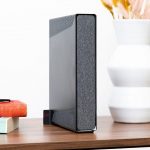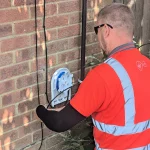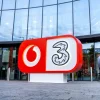Ofcom Propose Part of 1900MHz Band for 5G Mobile on UK Rail Network

The UK telecoms regulator, Ofcom, has today proposed to make part of the 1900MHz radio spectrum band (1900-1920MHz), which was previously awarded for mobile operators but has since gone unused, available for use by both the UK’s rail network (5G mobile / broadband services) and to extend coverage for the 4G Emergency Services Network (ESN).
Just to be clear, the major mobile network operators do in fact make use of spectrum frequency in this band, but today’s news specifically concerns the smaller 20MHz piece of unpaired spectrum in that band that has gone unused.
However, mobile operators have shunned this part of the band, not least as none of them wanted to deploy higher-power services in the spectrum, due to the lack of an ecosystem, as well as the need for a guard band against paired spectrum (reducing an already limited pot of spectrum) and the limited bandwidth it offers.
Advertisement
The regulator has thus been investigating alternative approaches and has today published a new consultation, which makes the following proposals.
The Regulator’s Proposal
➤ Authorise 1900–1910 MHz for operational rail communications to enable the rollout of FRMCS. The proposed new FRMCS licences would:
Be restricted to the provision of operational rail communications.
Contain technical conditions suitable for the deployment of FRMCS.
Require technical coordination with other existing or future FRMCS licensees in overlapping or neighbouring geographic areas.
Be issued via a simple process, with checks on applicants’ ability to comply with key licence conditions.
➤ Authorise 1910–1915 MHz to enable Emergency Services Network (ESN) gateways. The proposed licence would:
Be restricted to the provision of ESN gateways by the provider that is contracted by the UK Government to supply these gateways (currently BT / EE).
Have a fixed duration, aligned with the contract to supply ESN gateways.
Allow use throughout Great Britain.
Contain technical conditions consistent with standards used by the ESN.
➤ Set fees based on the opportunity cost of the spectrum. Our proposed annual fee for 1900–1910 MHz is £145,800 per MHz for a licence covering Great Britain and £4,200 per MHz for a licence covering Northern Ireland. Fees would be half these levels in 1910–1915 MHz to reflect the lower power levels permitted. This means that the total annual fee would be:
£1,458,000 for 1900–1910 MHz for a FRMCS licence covering Great Britain, and £42,000 for a licence covering Northern Ireland. Licences for smaller rail networks would pay a smaller fee, scaled by the length of the rail routes covered.
£364,500 for 1910–1915 MHz for an ESN gateway licence covering Great Britain.
Fees would be payable from 3 April 2029 when the spectrum becomes available.
At present, Ofcom are NOT proposing to authorise any use in the final 1915–1920MHz part of the aforementioned band, “primarily because of the power restrictions necessary to protect the mobile band above 1920MHz from interference, as well as uncertainty over demand for the spectrum“.
In terms of the 5G improvements envisaged for the 10MHz of spectrum frequency between 1900-1910MHz, Ofcom said “this would help replace the existing 2G technology, and enable trains, signalling and level crossings to be better connected, helping to reduce delays and make the rail network run more efficiently. As this frequency band is harmonised around Europe for rail networks, the UK rail industry would benefit from widely available equipment to deploy new technology using this spectrum“.
As for the ESN improvements between 1910–1915MHz, Ofcom said this would be through the use of ‘gateways’ – equipment installed on emergency vehicles such as ambulances. “These will enable emergency services to communicate in hard-to-reach areas, like underground car parks and remote rural areas,” added the regulator.
Advertisement
Ofcom is open to feedback on these proposals until 19th May 2025, and they currently intend to publish a statement setting out their decisions in Q3 2025/26.
Mark is a professional technology writer, IT consultant and computer engineer from Dorset (England), he also founded ISPreview in 1999 and enjoys analysing the latest telecoms and broadband developments. Find me on X (Twitter), Mastodon, Facebook, BlueSky, Threads.net and Linkedin.
« Anchor Confirm WiFi Upgrade for 1,700 Housing and Care Locations in England






















































This appears to be for rail internal users. I suppose it could be used to supplement GSM-R which is a voice and low-speed data network.
Potential use as back-haul for train wifi?
FRMCS is intended to replace GSM-R – see https://uic.org/rail-system/telecoms-signalling/frmcs
Since Network Rail (soon to be GB Railways?) and NI Railways are the likely future owners of that spectrum, it seems a bit pointless for one arm of the government to charge licence fees to another part of the government.
Interesting point – I wonder if any of the other government owned bodies who have spectrum licenses (e.g. MoD) have to pay back to Ofcom
If it costs then someone is going to be keeping an eye on it and will be keen to turn it off when no longer required. If it’s “free” then it’s likely to be abused.
Will be interesting to see if this results in more trackside masts having to be built out – GSM-R currently operates on 900mhz.
At least a 5G system will likely be more compact when they build it out – some of the trackside GSM-R masts have massive shipping container-sized boxes of equipment
Interesting! CableFree have already deployed b39/n39 (1900MHz, TDD) on live trackside deployments in Belgium. It’s GSM-R replacement tech. Other countries planning likewise.
Radios are modern, tower mount design & don’t necessarily need any trackside cabinet space, depending on system design. Bonus point: universal 4G/5G radios can be software switched from 4G to 5G remotely without visiting sites.
I’m pretty sure everyone is paying Ofcom. Well, except MoD who just do their own thing (not the only country).